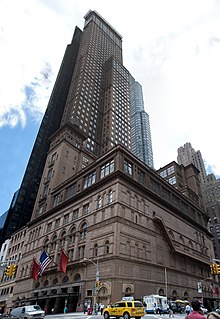This biography of a living person needs additional citations for verification .(August 2018) (Learn how and when to remove this template message) |
Roger Humphries | |
|---|---|
| Born | January 30, 1944 Pittsburgh, Pennsylvania, U.S. |
| Genres | Jazz |
| Occupation(s) | Musician |
| Instruments | Drums |
| Associated acts | Horace Silver, Carmell Jones, Jimmy Ponder, Ray Charles |
| Website | http://www.rogerhumphriesband.com/ |
Roger Humphries (born January 30, 1944) is an American jazz drummer.
Jazz is a music genre that originated in the African-American communities of New Orleans, United States, in the late 19th and early 20th centuries, and developed from roots in blues and ragtime. Jazz is seen by many as "America's classical music". Since the 1920s Jazz Age, jazz has become recognized as a major form of musical expression. It then emerged in the form of independent traditional and popular musical styles, all linked by the common bonds of African-American and European-American musical parentage with a performance orientation. Jazz is characterized by swing and blue notes, call and response vocals, polyrhythms and improvisation. Jazz has roots in West African cultural and musical expression, and in African-American music traditions including blues and ragtime, as well as European military band music. Intellectuals around the world have hailed jazz as "one of America's original art forms".
Contents
Born into a family of ten children in Pittsburgh, Pennsylvania, Humphries began playing drums at age four, and went professional at age 14. He led an ensemble at Carnegie Hall at age 16. Early in the 1960s, he began touring with jazz musicians; one of his more prominent gigs was in a trio with Stanley Turrentine and Shirley Scott in 1962. In 1964, he worked with Horace Silver, appearing on the album Song for My Father , where he played on four tracks, including the title tune. (On the same album Roy Brooks played on two tracks from a session recorded a year earlier). Following this Humphries drummed for Ray Charles.

Carnegie Hall is a concert venue in Midtown Manhattan in New York City, United States, located at 881 Seventh Avenue, occupying the east side of Seventh Avenue between West 56th Street and West 57th Street, two blocks south of Central Park.

Stanley William Turrentine was an American jazz tenor saxophonist. He began his career playing R&B for Earl Bostic and later soul jazz recording for the Blue Note label from 1960, touched on jazz fusion during a stint on CTI in the 1970s. He was described by critic Steve Huey as "renowned for his distinctively thick, rippling tone [and] earthy grounding in the blues." Turrentine was married to organist Shirley Scott in the 1960s, with whom he frequently recorded, and was the younger brother of trumpeter Tommy Turrentine.

Shirley Scott was an American jazz organist.
Humphries's list of credits in jazz, R&B, and pop is extensive. Musicians he has played with, in addition to the above, include Lee Morgan, Grant Green, Billy Taylor, Bill Doggett, Benny Green, Lionel Hampton, Coleman Hawkins, Barry Harris, Clark Terry, J. J. Johnson, Billy Preston, Joe Henderson, Freddie Hubbard, Dizzy Gillespie, Jack McDuff, Gene Harris, George Harris, George Benson, Jon Faddis, Slide Hampton, Johnny Griffin, Herbie Mann, Randy Brecker, Joe Williams, Milt Jackson, Jimmy Witherspoon, Hubert Laws, Dwayne Dolphin, Isley Brothers, and Illinois Jacquet.

Edward Lee Morgan was an American jazz trumpeter. Known mainly as one of the key hard bop musicians of the 1960s, Morgan came to prominence in his late teens, recording on John Coltrane's Blue Train (1957) and with the band of drummer Art Blakey before launching a solo career. Morgan stayed with Blakey until 1961 and started to record as leader soon after. His song "The Sidewinder", on the album of the same name, became a surprise crossover hit on the pop and R&B charts in 1964, while Morgan's recordings found him touching on other styles of music as his artistry matured. Soon after The Sidewinder was released, Morgan rejoined Blakey for a short period of time. After leaving Blakey for the final time, Morgan continued to work prolifically as both a leader and a sideman with the likes of Hank Mobley and Wayne Shorter, becoming, in the words of critic Steve Huey, "[a] cornerstone of the Blue Note label roster". Morgan's career was cut short at the age of 33, when his common-law wife shot and killed him following a confrontation at Slug's Saloon.

Grant Green was an American jazz guitarist and composer.

William Taylor was an American jazz pianist, composer, broadcaster and educator. He was the Robert L. Jones Distinguished Professor of Music at East Carolina University in Greenville, and from 1994 was the artistic director for jazz at the John F. Kennedy Center for the Performing Arts in Washington, D.C.
Humphries led his own band in the early 1970s, R.H. Factor, and led ensembles under other names into the 1990s. He has also held teaching positions at the University of Pittsburgh and the Pittsburgh High School for the Creative and Performing Arts. He released albums under his own name in 1993, 2003, and 2011.

The University of Pittsburgh is a state-related research university in Pittsburgh, Pennsylvania. It was founded as the Pittsburgh Academy in 1787 on the edge of the American frontier. It developed and was renamed as Western University of Pennsylvania by a change to its charter in 1819. After surviving two devastating fires and various relocations within the area, the school moved to its current location in the Oakland neighborhood of the city; it was renamed as the University of Pittsburgh in 1908. Pitt was a private institution until 1966 when it became part of the Commonwealth System of Higher Education.









